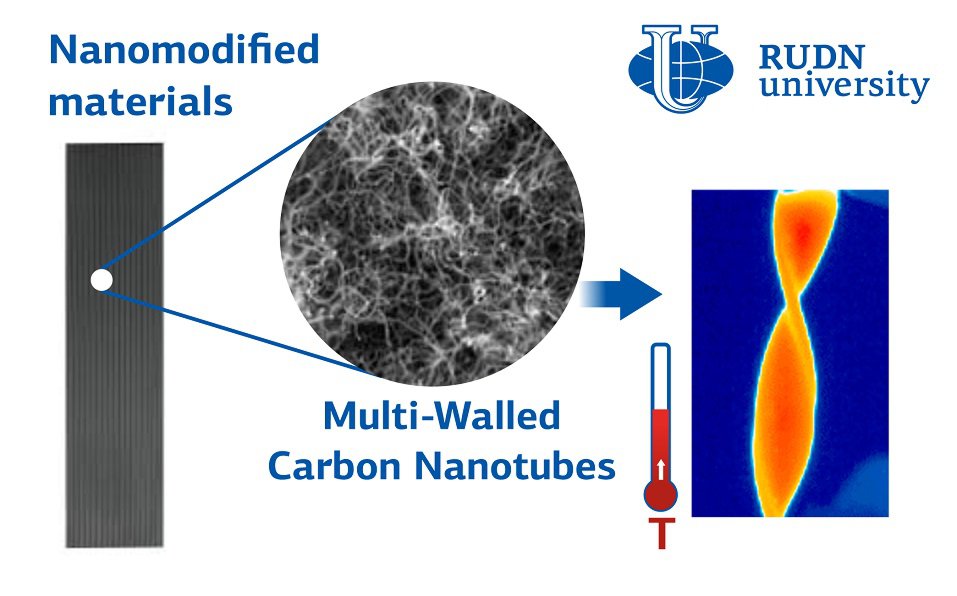RUDN University nanotechnologists have created a new elastic composite

One of the most relevant areas of modern materials science is functional materials. These are composites, polymers and alloys with physical and chemical properties that can be “customized” depending on the purpose of use. Such materials are used in electronics, medicine, cosmetics and other fields. RUDN University nanotechnologists have created a new composite material from an organosilicon base and carbon nanotubes. It can change temperature and electrical conductivity depending on deformation.
“The development of functional materials that can be used in technological fields is of great importance in materials science. Particular attention has been paid to nanomodified materials, which exhibit fundamentally new properties,” Alexander Vecher, Candidate of Biological Sciences, Deputy Director of the Nanotechnologies Research Center, RUDN University.
Nanotechnologists have created a composite based on the organosilicon compound Silagerm 803. This substance has the properties of an elastomer - it can stretch to sizes many times larger than the initial ones. Trying different conditions, the scientists modified the elastomer with multi-walled carbon nanotubes. Nanotubes are hollow cylinders with a diameter of several nanometers and a length of up to several centimeters. Nanotechnologists then studied how the properties of the new composite changed - they stretched it, twisted it, and passed a current through it, while measuring the temperature.
Samples with a concentration of carbon nanotubes from 1% to 5% by weight did not heat up when passing an electric current, and they had low conductivity. When twisted 360 degrees, the elastomer was heated at the center to a temperature of 76.3℃. If the twist was increased to 540 degrees and held in this position for 20 seconds, the temperature increased to 101.7℃. When the elastomer was stretched, the electrical conductivity of the samples increased. New materials can be used, for example, for strain gauge sensors - they convert mechanical deformation into an electrical signal. Another potential application is systems with controlled heating capabilities.
“The resulting samples can be used for sensitive elements of strain gauges. This will make it possible to obtain information about physical and chemical parameters from the electrical resistance that occurs during stretching and torsion. Our results allow us to take the next step towards the development of flexible functional materials for electrical heating and strain measurement,” Alexander Vecher, Candidate of Biological Sciences, Deputy Director of the Nanotechnologies Research Center, RUDN University.
The results were published in the Journal of Composites Science.
RUDN summarized the results of the scientific competition "Project Start: work of the science club ". Students of the Faculty of Physics, Mathematics and Natural Sciences have created a project for a managed queuing system using a neural network to redistribute resources between 5G segments. How to increase flexibility, make the network fast and inexpensive and reach more users — tell Gebrial Ibram Esam Zekri ("Fundamental Computer Science and Information Technology", Master's degree, II course) and Ksenia Leontieva ("Applied Mathematics and Computer Science", Master's degree, I course).
The National Demographic Report, 2023 Demographic Well-Being of Russian Regions (hereinafter - the National Demographic Report) was prepared by the scientific team of the Institute of Demographic Studies of the Federal Research Center of the Russian Academy of Sciences, the Vologda Scientific Center of the Russian Academy of Sciences, Peoples' Friendship University of Russia, the Center for Family and Demography of the Academy of Sciences of the Republic of Tatarstan, as well as with the participation of leading scientists from the Republic of Bashkortostan, Stavropol Krai, Volgograd, Ivanovo, Kaliningrad, Nizhny Novgorod, Sverdlovsk Oblasts and Khanty-Mansi Autonomous Okrug–Yugra.
RUDN summarized the results of the scientific competition "Project Start: work of the science club ". Students of the Faculty of Physics, Mathematics and Natural Sciences have created a project for a managed queuing system using a neural network to redistribute resources between 5G segments. How to increase flexibility, make the network fast and inexpensive and reach more users — tell Gebrial Ibram Esam Zekri ("Fundamental Computer Science and Information Technology", Master's degree, II course) and Ksenia Leontieva ("Applied Mathematics and Computer Science", Master's degree, I course).
What is your first association with the word “laboratory”? Flasks and beakers? Microscopes and centrifuges? Yes, many of us would answer the same way.
The National Demographic Report, 2023 Demographic Well-Being of Russian Regions (hereinafter - the National Demographic Report) was prepared by the scientific team of the Institute of Demographic Studies of the Federal Research Center of the Russian Academy of Sciences, the Vologda Scientific Center of the Russian Academy of Sciences, Peoples' Friendship University of Russia, the Center for Family and Demography of the Academy of Sciences of the Republic of Tatarstan, as well as with the participation of leading scientists from the Republic of Bashkortostan, Stavropol Krai, Volgograd, Ivanovo, Kaliningrad, Nizhny Novgorod, Sverdlovsk Oblasts and Khanty-Mansi Autonomous Okrug–Yugra.